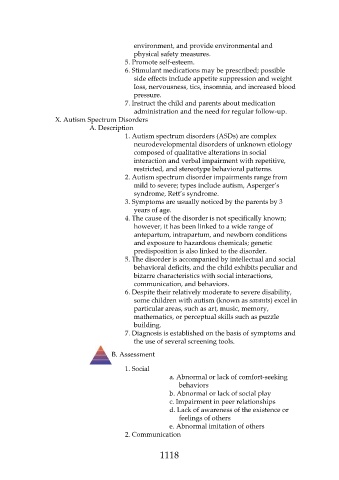Page 1118 - Saunders Comprehensive Review For NCLEX-RN
P. 1118
environment, and provide environmental and
physical safety measures.
5. Promote self-esteem.
6. Stimulant medications may be prescribed; possible
side effects include appetite suppression and weight
loss, nervousness, tics, insomnia, and increased blood
pressure.
7. Instruct the child and parents about medication
administration and the need for regular follow-up.
X. Autism Spectrum Disorders
A. Description
1. Autism spectrum disorders (ASDs) are complex
neurodevelopmental disorders of unknown etiology
composed of qualitative alterations in social
interaction and verbal impairment with repetitive,
restricted, and stereotype behavioral patterns.
2. Autism spectrum disorder impairments range from
mild to severe; types include autism, Asperger’s
syndrome, Rett’s syndrome.
3. Symptoms are usually noticed by the parents by 3
years of age.
4. The cause of the disorder is not specifically known;
however, it has been linked to a wide range of
antepartum, intrapartum, and newborn conditions
and exposure to hazardous chemicals; genetic
predisposition is also linked to the disorder.
5. The disorder is accompanied by intellectual and social
behavioral deficits, and the child exhibits peculiar and
bizarre characteristics with social interactions,
communication, and behaviors.
6. Despite their relatively moderate to severe disability,
some children with autism (known as savants) excel in
particular areas, such as art, music, memory,
mathematics, or perceptual skills such as puzzle
building.
7. Diagnosis is established on the basis of symptoms and
the use of several screening tools.
B. Assessment
1. Social
a. Abnormal or lack of comfort-seeking
behaviors
b. Abnormal or lack of social play
c. Impairment in peer relationships
d. Lack of awareness of the existence or
feelings of others
e. Abnormal imitation of others
2. Communication
1118

